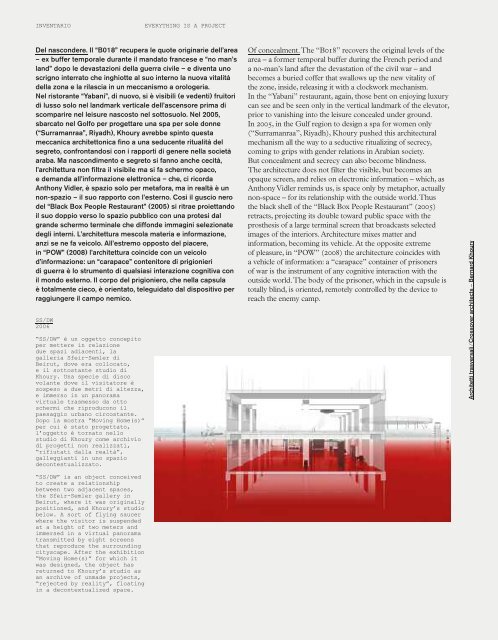Inventario02_Khoury
Inventario02_Khoury
Inventario02_Khoury
Create successful ePaper yourself
Turn your PDF publications into a flip-book with our unique Google optimized e-Paper software.
InventarIO<br />
ss/dW<br />
2006<br />
“ss/dW” è un oggetto concepito<br />
per mettere in relazione<br />
due spazi adiacenti, la<br />
galleria sfeir-semler di<br />
Beirut, dove era collocato,<br />
e il sottostante studio di<br />
khoury. Una specie di disco<br />
volante dove il visitatore è<br />
sospeso a due metri di altezza,<br />
e immerso in un panorama<br />
virtuale trasmesso da otto<br />
schermi che riproducono il<br />
paesaggio urbano circostante.<br />
dopo la mostra “moving home(s)”<br />
per cui è stato progettato,<br />
l’oggetto è tornato nello<br />
studio di khoury come archivio<br />
di progetti non realizzati,<br />
“rifiutati dalla realtà”,<br />
galleggianti in uno spazio<br />
decontestualizzato.<br />
“ss/dW” is an object conceived<br />
to create a relationship<br />
between two adjacent spaces,<br />
the sfeir-semler gallery in<br />
Beirut, where it was originally<br />
positioned, and khoury’s studio<br />
below. a sort of flying saucer<br />
where the visitor is suspended<br />
at a height of two meters and<br />
immersed in a virtual panorama<br />
transmitted by eight screens<br />
that reproduce the surrounding<br />
cityscape. after the exhibition<br />
“moving home(s)” for which it<br />
was designed, the object has<br />
returned to khoury’s studio as<br />
an archive of unmade projects,<br />
“rejected by reality”, floating<br />
in a decontextualized space.<br />
everythIng Is a prOject<br />
Del nascondere. Il “B018” recupera le quote originarie dell’area<br />
– ex buffer temporale durante il mandato francese e “no man’s<br />
land” dopo le devastazioni della guerra civile – e diventa uno<br />
scrigno interrato che inghiotte al suo interno la nuova vitalità<br />
della zona e la rilascia in un meccanismo a orologeria.<br />
Nel ristorante “Yabani”, di nuovo, si è visibili (e vedenti) fruitori<br />
di lusso solo nel landmark verticale dell’ascensore prima di<br />
scomparire nel leisure nascosto nel sottosuolo. Nel 2005,<br />
sbarcato nel Golfo per progettare una spa per sole donne<br />
(“Surramanraa”, Riyadh), <strong>Khoury</strong> avrebbe spinto questa<br />
meccanica architettonica fino a una seducente ritualità del<br />
segreto, confrontandosi con i rapporti di genere nella società<br />
araba. Ma nascondimento e segreto si fanno anche cecità,<br />
l’architettura non filtra il visibile ma si fa schermo opaco,<br />
e demanda all’informazione elettronica – che, ci ricorda<br />
Anthony Vidler, è spazio solo per metafora, ma in realtà è un<br />
non-spazio – il suo rapporto con l’esterno. Così il guscio nero<br />
del “Black Box People Restaurant” (2005) si ritrae proiettando<br />
il suo doppio verso lo spazio pubblico con una protesi dal<br />
grande schermo terminale che diffonde immagini selezionate<br />
degli interni. L’architettura mescola materia e informazione,<br />
anzi se ne fa veicolo. All’estremo opposto del piacere,<br />
in “POW” (2008) l’architettura coincide con un veicolo<br />
d’informazione: un “carapace” contenitore di prigionieri<br />
di guerra è lo strumento di qualsiasi interazione cognitiva con<br />
il mondo esterno. Il corpo del prigioniero, che nella capsula<br />
è totalmente cieco, è orientato, teleguidato dal dispositivo per<br />
raggiungere il campo nemico.<br />
Of concealment.The “B018” recovers the original levels of the<br />
area – a former temporal buffer during the French period and<br />
a no-man’s land after the devastation of the civil war – and<br />
becomes a buried coffer that swallows up the new vitality of<br />
the zone, inside, releasing it with a clockwork mechanism.<br />
In the “Yabani” restaurant, again, those bent on enjoying luxury<br />
can see and be seen only in the vertical landmark of the elevator,<br />
prior to vanishing into the leisure concealed under ground.<br />
In 2005, in the Gulf region to design a spa for women only<br />
(“Surramanraa”, Riyadh), <strong>Khoury</strong> pushed this architectural<br />
mechanism all the way to a seductive ritualizing of secrecy,<br />
coming to grips with gender relations in Arabian society.<br />
But concealment and secrecy can also become blindness.<br />
The architecture does not filter the visible, but becomes an<br />
opaque screen, and relies on electronic information – which, as<br />
Anthony Vidler reminds us, is space only by metaphor, actually<br />
non-space – for its relationship with the outside world. Thus<br />
the black shell of the “Black Box People Restaurant” (2005)<br />
retracts, projecting its double toward public space with the<br />
prosthesis of a large terminal screen that broadcasts selected<br />
images of the interiors. Architecture mixes matter and<br />
information, becoming its vehicle. At the opposite extreme<br />
of pleasure, in “POW” (2008) the architecture coincides with<br />
a vehicle of information: a “carapace” container of prisoners<br />
of war is the instrument of any cognitive interaction with the<br />
outside world. The body of the prisoner, which in the capsule is<br />
totally blind, is oriented, remotely controlled by the device to<br />
reach the enemy camp.<br />
Architetti trasversali ⁄ Crossover architects – Bernard <strong>Khoury</strong>


